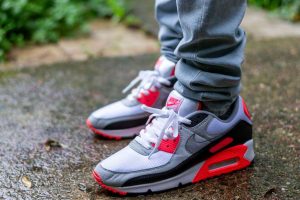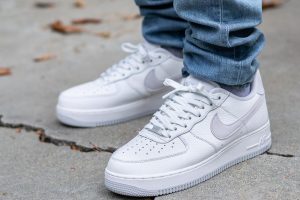As one of the top sneaker companies in the world, Nike’s status as a company is unquestionable. But does the craftsmanship of their products match their reputation? Here we examine if Nikes are actually good quality.
Nikes Are Good Quality
For a company that generates thousands of mass-produced sneakers, Nike’s quality is relatively good. Different releases have differing levels of quality which is not always reflected in their pricing structure.

The price tag here is based on packaging
and nostalgia rather than material quality.
There are both subjective and objective ways to view sneaker quality. Generally speaking, here we will be referring to materials, build and QC. Keep in mind that each person’s perception of quality may differ from the actual level of quality used.
Often times, the price Nike charges for a shoe does not directly correlate to the quality of the materials or build. For example, the recent Air Max 90 Infrared retro carries a higher retail price than a GR (general release) pair of 90s. However, this is based more on nostalgia and packaging. These kicks came with a special box, hangtag, and other features that play on the vibe of the original 1990 release of the sneaker. The quality however is fairly basic as far as the suedes and leathers used. The point being that with Nike, a higher price does not always translate to better quality.
Nike Is Not Considered A Luxury Brand
Nike is not technically considered a luxury or designer brand. It is however considered one of the premier athletic footwear brands in the world. The brand does on occasion collaborate with other luxury brands on some of its products.
While not a luxury brand per se, it is one of the most valuable athletic footwear and apparel brands in existence.
Nike Is A Good Quality Brand
As a footwear brand, Nike is in the top tier. They are to athletic sneakers what a brand like Coke is to soda. Given that Nikes are often mass produced, the quality of their actual products varies.

The Space Hippie line focuses on Nikes
Move to Zero – recycling waste created
during production into new sneakers while
lowering emissions from its factories.
As a brand, Nike is just as recognizable as any of the major brands in any industry. They have built a reputation over time with innovative technology, celebrity endorsements, and a certain “cool” factor that is difficult to replicate. This high brand equity can, but does not always, translate to their products.
While Nike has good branding overall, and releases some pairs with excellent quality, it’s not all roses when it comes to their company image. They have often come under fire for subpar working conditions and treatment of the environment as far as their production goes. While they have attempted to mitigate some of this with their Move to Zero efforts, the company still has a ways to go in order to rectify their image in this aspect.
Where Nike Gets Their Materials From
Nike gets many of it’s materials from Asia, Australia and South America. Nike’s manufacturers (independent contractors and suppliers) typically source the materials for production directly.
Nike Does Sometimes Use Real Leather
Nike sometimes uses real leather. Other times they use synthetic leather, depending on the release.

This sneaker takes the quality of the Air Force 1
and multiplies it for a truly premium release.
I have some more details about this in my article on whether Nike Air Force 1s are real leather. Long story short though, Nike uses synthetic or composite materials in many of their products due to price, breathability and ease of cleaning.
An easy example to look at is the Air Force 1 line, one of Nike’s most recognizable since its inception in the early 80s. GR pairs tend to have plasticky synthetic leather, while pairs labeled as premium may have better quality materials. Sometimes the ‘premium’ designation refers to better laces, fancy insole graphics, additional embroidery, or other features not directly related to material quality or build. Other times, it purely refers to upgraded suede or leather. Occasionally we even get both in one release.
The Air Force 1 craft line for example gives us better leather quality as a selling point. A pair of crafts might go for $120 retail, while a GR pair of Forces is typically around $90. Premium AF1s can retail for as much as $150 but may deliver less actual quality than the AF1 craft regarding the materials.
Nike’s “Good” Quality Compared to Other Brands
While Nike does well considering how many sneakers it makes, some releases from other brands such as those from New Balance’s “Made in USA” line up the ante in terms of materials and craftsmanship.
New Balance’s Made lines receive a bit more care and attention in production. The sneakers are produced in smaller batches in the US or England, depending on the line. These pairs therefore receive more attention to detail than their GR counterparts.
Nike does label some pairs as premium, however sneaker production quality will inherently suffer if produced in large batches. Even quality assurance departments at Nike can miss things as they have to examine large batches of sneakers. Shoes made in this way simply can’t receive the level of attention that a limited run of domestically produced sneakers gets.
That said, there are still plenty of Nikes that are good quality. These use better materials and have more attention to detail, all things considered. Just don’t expect that to be directly related to the price of that particular shoe.
